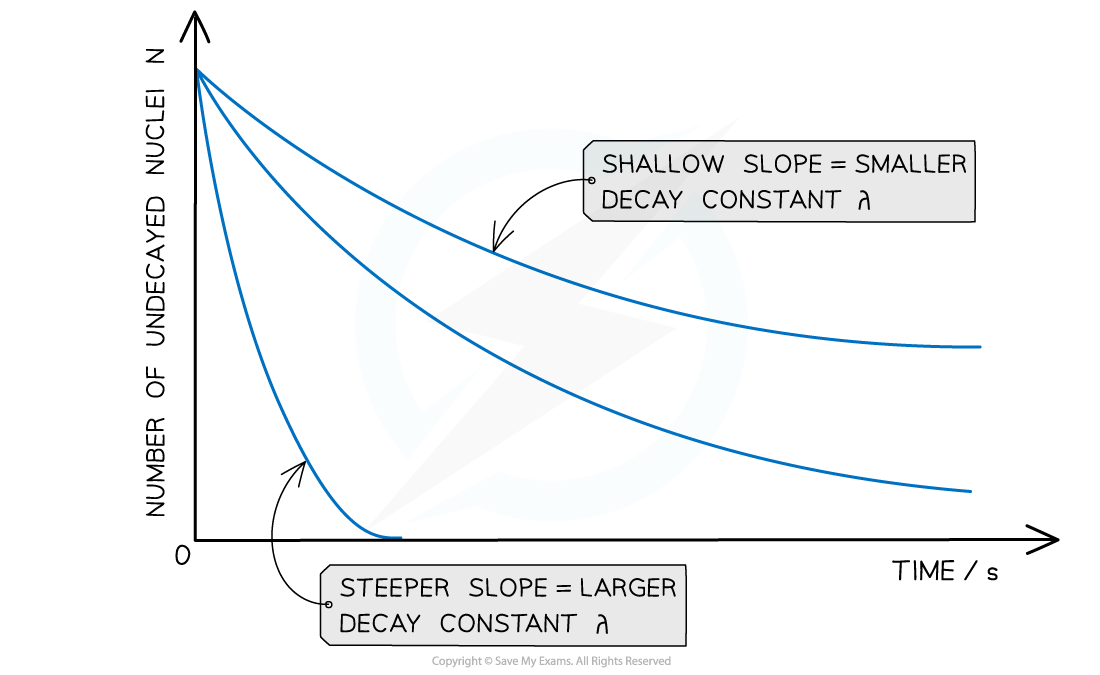- 翰林提供学术活动、国际课程、科研项目一站式留学背景提升服务!
- 400 888 0080
CIE A Level Physics复习笔记23.2.2 Activity & The Decay Constant
Activity & The Decay Constant
- Since radioactive decay is spontaneous and random, it is useful to consider the average number of nuclei which are expected to decay per unit time
- This is known as the average decay rate
- As a result, each radioactive element can be assigned a decay constant
- The decay constant λ is defined as:
The probability that an individual nucleus will decay per unit of time
- When a sample is highly radioactive, this means the number of decays per unit time is very high
- This suggests it has a high level of activity
- Activity, or the number of decays per unit time can be calculated using:

- Where:
- A = activity of the sample (Bq)
- ΔN = number of decayed nuclei
- Δt = time interval (s)
- λ = decay constant (s-1)
- N = number of nuclei remaining in a sample
- The activity of a sample is measured in Becquerels (Bq)
- An activity of 1 Bq is equal to one decay per second, or 1 s-1
- This equation shows:
- The greater the decay constant, the greater the activity of the sample
- The activity depends on the number of undecayed nuclei remaining in the sample
- The minus sign indicates that the number of nuclei remaining decreases with time - however, for calculations it can be omitted
Worked Example
Americium-241 is an artificially produced radioactive element that emits α-particles. A sample of americium-241 of mass 5.1 μg is found to have an activity of 5.9 × 105 Bq.
Part (a)
Step 1: Write down the known quantities
-
- Mass = 5.1 μg = 5.1 × 10-6 g
- Molecular mass of americium = 241
- NA = Avogadro constant
Step 2: Write down the equation relating number of nuclei, mass and molecular mass
 Step 3: Calculate the number of nuclei
Step 3: Calculate the number of nuclei

Part (b)
Step 1: Write the equation for activity
Activity, A = λN
Step 2: Rearrange for decay constant λ and calculate the answer
 The Exponential Nature of Radioactive Decay
The Exponential Nature of Radioactive Decay
- In radioactive decay, the number of nuclei falls very rapidly, without ever reaching zero
- Such a model is known as exponential decay
- The graph of number of undecayed nuclei and time has a very distinctive shape

Radioactive decay follows an exponential pattern. The graph shows three different isotopes each with a different rate of decay
Equations for Radioactive Decay
- The number of undecayed nuclei N can be represented in exponential form by the equation:
N = N0e–λt
- Where:
- N0 = the initial number of undecayed nuclei (when t = 0)
- λ = decay constant (s-1)
- t = time interval (s)
- The number of nuclei can be substituted for other quantities, for example, the activity A is directly proportional to N, so it can be represented in exponential form by the equation:
A = A0e–λt
- The received count rate C is related to the activity of the sample, hence it can also be represented in exponential form by the equation:
C = C0e–λt
The exponential function e
- The symbol e represents the exponential constant
- It is approximately equal to e = 2.718
- On a calculator it is shown by the button ex
- The inverse function of ex is ln(y), known as the natural logarithmic function
- This is because, if ex = y, then x = ln(y)
Worked Example
Strontium-90 decays with the emission of a β-particle to form Yttrium-90. The decay constant of Strontium-90 is 0.025 year-1.
Determine the activity A of the sample after 5.0 years, expressing the answer as a fraction of the initial activity A0
Step 1: Write out the known quantities
Decay constant, λ = 0.025 year-1
Time interval, t = 5.0 years
Both quantities have the same unit, so there is no need for conversion
Step 2: Write the equation for activity in exponential form
A = A0e–λt
Step 3: Rearrange the equation for the ratio between A and A0

Step 4: Calculate the ratio A/A0

Therefore, the activity of Strontium-90 decreases by a factor of 0.88, or 12%, after 5 years
转载自savemyexams

最新发布
© 2025. All Rights Reserved. 沪ICP备2023009024号-1









